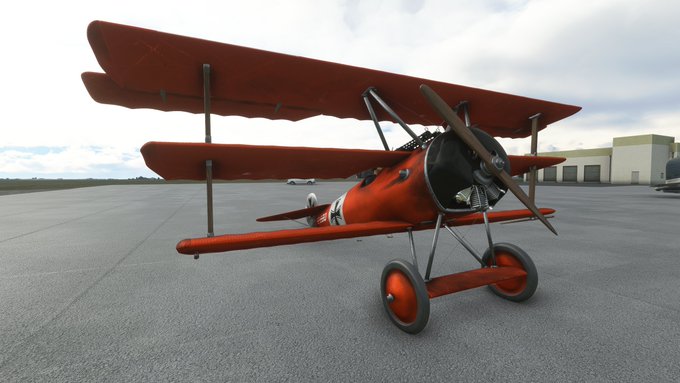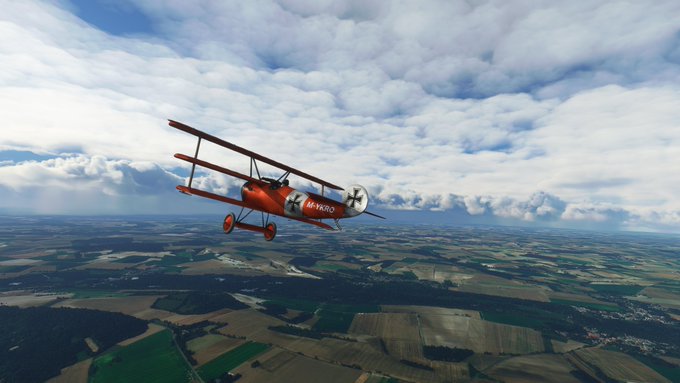December 13, 2022
Today in Microsoft Flight Simulator I’m going to be checking out the Fokker Dr.I triplane, made famous in World War I by “The Red Baron”.

For anyone who missed it, you might want to check out my earlier post on the French-build Nieuport 17, which offers a good backdrop for this new post today.

The Fokker Dr.I was introduced in late 1917. It was a response to much-improved Allied fighter planes, including the Sopwith Camel. But it was directly inspired by the Sopwith Triplane (or “Tripe”), one of which had been shot down and captured by the Germans and studied.

To understand a triplane, it’s useful to ask why did people fly biplanes in World War I, but not in World War II? It basically boils down to two things: low engine power, and the weakness of the materials (wood and fabric) they were using.

The engines used in WWI planes typically produced just over 100 horsepower (compared to a small Cessna 172 that produces 180hp). This meant they were relatively slow, and had to produce more lift relative to thrust.

One way was to make the wings longer. But because they were made of wood and fabric, unless they were strongly supported by wires, longer wings could easily snap off – especially when doing acrobatic maneuvers in combat.

Later, the solution was to construct aircraft out of strong (and light) aluminum frames. But in WWI, the only alternative was to add a second wing for more lift, even though it added significantly to drag.

Triplanes took this one step further. In fact, the Fokker Dr.I actually had a fourth wing, a smaller airfoil connecting its wheels that also contributed significantly to lift.

I’ll talk more about the advantages and disadvantages all these wings brought with them, but for now, let’s get into the air. I’m back at Albert in northern France again, to reenact the Red Baron’s last fatal flight on April 21, 1918.

Wait a minute, wasn’t this Allied-held territory back in 1916, when I flew the Nieuport 17 around this same area? Yes, but in the Spring of 1918, the Germans launched a huge last-ditch offensive that pushed the Allies back almost all the way to Amiens.

The first thing I’m going to note is that, as in real life, taxiing the Fokker Dr.I is a hell of a challenge. For one thing, all those wings almost completely block any forward view. Some pilots compare the wings to “venetian blind” that closes when the tail is down.

It’s not just that you can’t see. The airflow disrupted by all three wings gives you very poor rudder control. There are no brakes, so it tends to make you wobble all over the place. It was often said Dr.I pilots faced more danger on the ground than in combat.

But hey, look, I did succeed in getting off the ground on my first try. This is supposed to be real-time weather, by the way, in France an hour or so ago.

Manfred von Richthofen was a young Prussian aristocrat from Silesia, what is today part of Poland. He started the war as a cavalry officer, but soon join the new German air force, where he gained a reputation as a cold and calculating hunter in the air.

For easy recognition, German pilots often painted their planes in distinct and colorful designs, like the heraldry of a medieval knight. Richthofen came to paint his planes bright red, earning him the nickname The Red Baron (though he sometimes borrowed other planes for combat).

For most of his career, Richthofen did not fly the Dr.I, but earlier biplane fighters. But after he began flying the triplane in November 1917, he became a firm and vocal advocate. It was his favorite plane.

Why? For one thing, the lift from all those wings gave it a 50% better climb rate than any Allied foe. The ability to dive down onto your opponent, from the higher position, was a crucial advantage in combat.

Second, if you look head on, the wings of the Fokker Dr.I are absolutely straight. Normally they tilt slightly up to provide some stability. But an unstable airplane is more agile. more responsive – as long as you can retain control.

The Dr.I is very unstable. Many pilots compare it to flying a helicopter. It does not want to fly in a straight line. You have to keep your hands on the controls, making constant adjustments, all the time.

Now I was able, without too much difficulty, to do a loop.




But every time I tried to roll, I couldn’t get it out, and it just went into an unrecoverable death spin. That’s a stability issue, and you’d have to be master to overcome it.

Last but not least, all those wings blocked your view, leaving major blindspots. The Dr.I might be a better dogfighter, but that didn’t matter if the enemy saw you first – or you lost sight of him in the midst of battle.

One advantage of the triplane was the middle wing provided a lot of structural support, making it possible to do away with the vulnerable wires keeping the wings in place. It could take more damage and still hold together.

But all those wings also created a lot of drag, which made it slow. The Sopwith Camel, for instance, could outpace it by at least 15 mph, which meant it could engage or run away from the Dr.I at will.

The town I’m flying over right now is Cappy, a village along a bend in the River Somme where the Red Baron’s fighter squadron was based in April 1918. The airfield no longer exists.

On April 21, 1918, Richthofen was just 25 years old. He had 80 confirmed kills. He had become a huge celebrity in Germany, and the high command feared that, should anything happen to him, it could be a serious blow to morale.

The morning, wearing monogrammed silk pajamas beneath his fur-lined flying suit, Richthofen flew over the small ridge at Morlancourt, where his younger cousin Wolfram was engaged in a dogfight with enemy planes.

Of course, Richthofen would have climbed for advantage, probably a lot higher than I’m doing here. Once he saw one of the British planes’ guns jam, he descended for what he thought would be one more easy kill.

The Dr.I was armed with twin Spandau LMG 08/15 7.92x57mm machine guns. They too were prone to jamming, which is why they carried two.

Another British plane, a Camel flown by Canadian Captain Arthur Roy Brown (with 10 confirmed kills himself) swooped down behind Richthofen himself and fired, observing several hits.

Richthofen continued flying for well over a minute. It was not clear that Brown’s bullets had done him in.

Then a few moments later, Richthofen’s plane crashed in the small notch of tan field immediately below me, between the road and the trees, just outside the French village of Vaux-sur-Somme.

You can see the field here, on a second pass, right next to the car. Brown was credited with the kill, but there is a lot of mystery and controversy over who truly shot the Red Baron down.

The thinking these days is that Richthofen was most likely killed by a bullet fired by Australian anti-aircraft gunners on the ground, which punctured his chest and killed him immediately, causing his plane to crash.

I’m going to try to land the Fokker Dr.I now, in a somewhat larger field just beyond where the Red Baron crashed.

The Dr.I was – and is – known as notoriously difficult to land, mainly because you can’t see a damn thing straight ahead, especially once you level off. It also wants to float, because of all the lift from its wings.

I ended up ground looping almost immediately on landing, and nearly tipping over, because especially in 2D (on a computer screen) you just can’t tell if you’re veering off, and the rudder offers little control anyway.

Richthofen loved the Dr.I because it was an incredibly agile dogfighter, with an incredible climb rate. But that was because he was an excellent pilot, who could overcome most of its disadvantages by sheer skill.

Even so, the major obstructions to the view from the cockpit may have rendered him vulnerable to surprise attack, and contributed to his demise.

In any case, the Red Baron’s death was a blow to German morale – and took place just as the tide was turning against Germany’s final offensive on the Western Front. The Allies took the counteroffensive, and the war was over by November.

I hope you’ve enjoyed this short excursion into the skies over France in early 1918, as well as a closer look at an iconic airplane, the Fokker Dr.I triplane.

Leave a Reply